
Chinese city wall
Encyclopedia
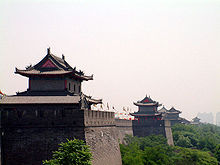
China
Chinese civilization may refer to:* China for more general discussion of the country.* Chinese culture* Greater China, the transnational community of ethnic Chinese.* History of China* Sinosphere, the area historically affected by Chinese culture...
in pre-modern times. The system consisted of walls, towers, and gates
City gate
A city gate is a gate which is, or was, set within a city wall. Other terms include port.-Uses:City gates were traditionally built to provide a point of controlled access to and departure from a walled city for people, vehicles, goods and animals...
, which were often built to a uniform standard throughout the Empire.
Meaning of the word Chengqiang
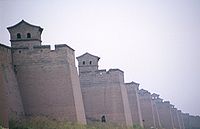
Chinese language
The Chinese language is a language or language family consisting of varieties which are mutually intelligible to varying degrees. Originally the indigenous languages spoken by the Han Chinese in China, it forms one of the branches of Sino-Tibetan family of languages...
word Chéngqiáng (城墙) can be used in two senses in the modern Chinese language
Chinese language
The Chinese language is a language or language family consisting of varieties which are mutually intelligible to varying degrees. Originally the indigenous languages spoken by the Han Chinese in China, it forms one of the branches of Sino-Tibetan family of languages...
. In a broad sense, it means all defensive wall
Defensive wall
A defensive wall is a fortification used to protect a city or settlement from potential aggressors. In ancient to modern times, they were used to enclose settlements...
s, including the Great Wall of China
Great Wall of China
The Great Wall of China is a series of stone and earthen fortifications in northern China, built originally to protect the northern borders of the Chinese Empire against intrusions by various nomadic groups...
, as well as similar structures in other countries such as Hadrian's Wall
Hadrian's Wall
Hadrian's Wall was a defensive fortification in Roman Britain. Begun in AD 122, during the rule of emperor Hadrian, it was the first of two fortifications built across Great Britain, the second being the Antonine Wall, lesser known of the two because its physical remains are less evident today.The...
. In a narrow sense, Chengqiang specifically refers to defensive walls built around a city or town.
In classical Chinese
Classical Chinese
Classical Chinese or Literary Chinese is a traditional style of written Chinese based on the grammar and vocabulary of ancient Chinese, making it different from any modern spoken form of Chinese...
, the character Chéng (城) denoted the defensive wall of the "inner city", housing government buildings. The character Guó (郭) denoted the defensive wall of the "outer city", housing mainly residences. The phrase Chángchéng (长城), literally "the Long Wall", specifically referred to the Great Wall
Great Wall of China
The Great Wall of China is a series of stone and earthen fortifications in northern China, built originally to protect the northern borders of the Chinese Empire against intrusions by various nomadic groups...
.
History

Xia Dynasty
The Xia Dynasty is the first dynasty in China to be described in ancient historical chronicles such as Bamboo Annals, Classic of History and Records of the Grand Historian. The Xia Dynasty was established by the legendary Yu the Great after Shun, the last of the Five Emperors gave his throne to him...
leader Gun (鲧), the father of Yu the Great
Yu the Great
Yu the Great , was a legendary ruler of Ancient China famed for his introduction of flood control, inaugurating dynastic rule in China by founding the Xia Dynasty, and for his upright moral character....
. It is said that Gun built the inner wall (城) to defend the prince, and the outer wall (郭) to settle the people. An alternative theory attributes the first city wall to the Yellow Emperor
Yellow Emperor
The Yellow Emperor or Huangdi1 is a legendary Chinese sovereign and culture hero, included among the Three Sovereigns and Five Emperors. Tradition holds that he reigned from 2697–2597 or 2696–2598 BC...
. A number of neolithic-period walls surrounding substantial settlements have been excavated in recent years. These include a supposed wall at a Liangzhu culture
Liangzhu culture
The Liangzhu culture was the last Neolithic jade culture in the Yangtze River Delta of China. Its area of influence extended from around Lake Tai north to Nanjing and the Chang Jiang, east to Shanghai and the sea, and south to Hangzhou...
site, a stone wall at Sanxingdui
Sanxingdui
Sanxingdui is the name of an archaeological site and its deduced culture in China, now believed to be the site of an ancient Chinese city. The previously unknown Bronze Age culture was re-discovered in 1987 when archaeologists excavated remarkable artifacts, that radiocarbon dating dated as being...
, and several tamped earth walls at the Longshan culture
Longshan culture
The Longshan culture was a late Neolithic culture in China, centered on the central and lower Yellow River and dated from about 3000 BC to 2000 BC...
site. These walls generally protected settlements the size of a large village.
In Shang Dynasty
Shang Dynasty
The Shang Dynasty or Yin Dynasty was, according to traditional sources, the second Chinese dynasty, after the Xia. They ruled in the northeastern regions of the area known as "China proper" in the Yellow River valley...
China
China
Chinese civilization may refer to:* China for more general discussion of the country.* Chinese culture* Greater China, the transnational community of ethnic Chinese.* History of China* Sinosphere, the area historically affected by Chinese culture...
, at the site of Ao, large walls were erected in the 15th century BC that had dimensions of 20 meters / 65 feet in width at the base and enclosed an area of some 2100 yards (1,920.2 m) squared. In similar dimensions, the ancient capital of the State of Zhao
Zhao (state)
Zhao was a significant Chinese state during the Warring States Period, along with six others...
, Handan
Handan
Handan is a prefecture-level city located in the southwestern part of Hebei Province of China.- History :Handan was the capital of the State of Zhao during the Warring States period , after the capital moved from Zhongmu. The city was conquered by the State of Qin after the virtual annexation of...
(founded in 386 BC), had walls that were again 20 meters / 65 feet wide at the base, a height of 15 meters / 50 feet tall, with two separate sides of its rectangular enclosure measured at a length of 1530 yards (1,399 m).
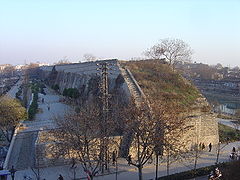
Zhou Dynasty
The Zhou Dynasty was a Chinese dynasty that followed the Shang Dynasty and preceded the Qin Dynasty. Although the Zhou Dynasty lasted longer than any other dynasty in Chinese history, the actual political and military control of China by the Ji family lasted only until 771 BC, a period known as...
onwards. For example, the city wall of Pingyao
Pingyao
Pingyao is a Chinese city and county in central Shanxi province, China. It lies about 715 km from Beijing and 80 km from the provincial capital, Taiyuan. During the Qing Dynasty, Pingyao was a financial center of China...
were first constructed between 827 BC and 782 BC, in the reign of King Xuan of Zhou
King Xuan of Zhou
King Xuan of Zhou was the eleventh sovereign of the Chinese Zhou Dynasty. Estimated dates of his reign are 827-782 BC or 827/25-782 BC.He worked to restore royal authority after the Gong He interregnum. He fought the 'Western Barbarians' and another group on the Huai River to the southeast. In...
. The city wall of Suzhou
Suzhou
Suzhou , previously transliterated as Su-chou, Suchow, and Soochow, is a major city located in the southeast of Jiangsu Province in Eastern China, located adjacent to Shanghai Municipality. The city is situated on the lower reaches of the Yangtze River and on the shores of Taihu Lake and is a part...
followed, prior to their demolition in the 1960s and 1970s, largely the same plan as set down by Wu Zixu
Wu Zixu
Wu Yun , better known by his style name Zixu , is the most famous ancestor of people with the surname of Wu . All branches of the Wu clans claim him as their "first ancestor"...
in the 5th century BC. By the Yuan Dynasty
Yuan Dynasty
The Yuan Dynasty , or Great Yuan Empire was a ruling dynasty founded by the Mongol leader Kublai Khan, who ruled most of present-day China, all of modern Mongolia and its surrounding areas, lasting officially from 1271 to 1368. It is considered both as a division of the Mongol Empire and as an...
, it was government policy that towns which were administrative seats of county-level units or above were to have defensive walls. In ancient China, sieges of city walls (along with naval battles) were portrayed on bronze
Bronze
Bronze is a metal alloy consisting primarily of copper, usually with tin as the main additive. It is hard and brittle, and it was particularly significant in antiquity, so much so that the Bronze Age was named after the metal...
'hu' vessels
Hu (vessel)
A hu is a type of pear-shaped ritual wine bronze vessel from ancient China. They would be placed in the grave of an ancestor as part of ritual banquet in order to ensure the good favor of that ancestor's spirit...
dated to the Warring States (5th century BC to 3rd century BC), like those found in Chengdu
Chengdu
Chengdu , formerly transliterated Chengtu, is the capital of Sichuan province in Southwest China. It holds sub-provincial administrative status...
, Sichuan
Sichuan
' , known formerly in the West by its postal map spellings of Szechwan or Szechuan is a province in Southwest China with its capital in Chengdu...
, China in 1965.
The construction of city walls grew to a peak in the Ming Dynasty
Ming Dynasty
The Ming Dynasty, also Empire of the Great Ming, was the ruling dynasty of China from 1368 to 1644, following the collapse of the Mongol-led Yuan Dynasty. The Ming, "one of the greatest eras of orderly government and social stability in human history", was the last dynasty in China ruled by ethnic...
and Qing Dynasty
Qing Dynasty
The Qing Dynasty was the last dynasty of China, ruling from 1644 to 1912 with a brief, abortive restoration in 1917. It was preceded by the Ming Dynasty and followed by the Republic of China....
. Sophisticated construction techniques meant that major city walls, such as that in the capitals Beijing
Beijing
Beijing , also known as Peking , is the capital of the People's Republic of China and one of the most populous cities in the world, with a population of 19,612,368 as of 2010. The city is the country's political, cultural, and educational center, and home to the headquarters for most of China's...
and Nanjing
Nanjing
' is the capital of Jiangsu province in China and has a prominent place in Chinese history and culture, having been the capital of China on several occasions...
, were specifically built to withstand cannonfire. However, with the advent of modern Western firearms, traditional fortifications began to lose their defensive functions in the 19th and 20th centuries. The traditional city wall also proved an obstacle to efficient trade and intercourse. For example, the city wall of Shanghai
Shanghai
Shanghai is the largest city by population in China and the largest city proper in the world. It is one of the four province-level municipalities in the People's Republic of China, with a total population of over 23 million as of 2010...
, built to repel Wokou
Wokou
Wokou , which literally translates as "Japanese pirates" in English, were pirates of varying origins who raided the coastlines of China and Korea from the 13th century onwards...
raiders in the Ming dynasty
Ming Dynasty
The Ming Dynasty, also Empire of the Great Ming, was the ruling dynasty of China from 1368 to 1644, following the collapse of the Mongol-led Yuan Dynasty. The Ming, "one of the greatest eras of orderly government and social stability in human history", was the last dynasty in China ruled by ethnic...
, was almost completely demolished after the Xinhai Revolution
Xinhai Revolution
The Xinhai Revolution or Hsinhai Revolution, also known as Revolution of 1911 or the Chinese Revolution, was a revolution that overthrew China's last imperial dynasty, the Qing , and established the Republic of China...
at the request of the city's merchant community.
After the founding of the People's Republic of China
People's Republic of China
China , officially the People's Republic of China , is the most populous country in the world, with over 1.3 billion citizens. Located in East Asia, the country covers approximately 9.6 million square kilometres...
, a political dimension was added to the economic problem posed by city walls. In Beijing
Beijing
Beijing , also known as Peking , is the capital of the People's Republic of China and one of the most populous cities in the world, with a population of 19,612,368 as of 2010. The city is the country's political, cultural, and educational center, and home to the headquarters for most of China's...
, for example, the proposed demolition of the city walls was at first opposed by experts ranging from architect Liang Sicheng
Liang Sicheng
Liang Sicheng was the son of Liang Qichao, a well-known Chinese thinker in the late Qing Dynasty. Liang Sicheng returned to China from the United States after studying at the University of Pennsylvania...
, to Soviet
Soviet Union
The Soviet Union , officially the Union of Soviet Socialist Republics , was a constitutionally socialist state that existed in Eurasia between 1922 and 1991....
advisor Mosin, on the grounds that the city walls of Beijing were the most sophisticated and well-preserved system of city walls in China. However, in 1958 Mao Zedong
Mao Zedong
Mao Zedong, also transliterated as Mao Tse-tung , and commonly referred to as Chairman Mao , was a Chinese Communist revolutionary, guerrilla warfare strategist, Marxist political philosopher, and leader of the Chinese Revolution...
intervened, and declared that the demolition of the old city wall was a political issue. Despite mayor Peng Zhen
Peng Zhen
Peng Zhen was a leading member of the Communist Party of China.-Biography:Born in Houma , Peng was originally named Fu Maogong....
's efforts to preserve gates and towers, by 1970 almost all of the city wall had been demolished.
Composition
Many Chinese cities were deliberately sited and planned. City walls ,when not constrained by geography, tend to be rectangular or square. Philosophical and even feng shuiFeng shui
Feng shui ' is a Chinese system of geomancy believed to use the laws of both Heaven and Earth to help one improve life by receiving positive qi. The original designation for the discipline is Kan Yu ....
considerations were adopted in siting gates and towers, and the walled city itself.
Chinese cities rarely centre on a castle
Castle
A castle is a type of fortified structure built in Europe and the Middle East during the Middle Ages by European nobility. Scholars debate the scope of the word castle, but usually consider it to be the private fortified residence of a lord or noble...
. Instead, the city's administrative centre is spread over a relatively large area, which may or may not be surrounded by a second set of "inner" walls similar in shape and construction to the main, outer wall.
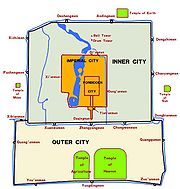
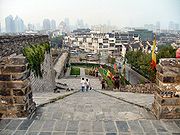
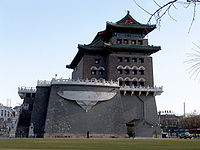
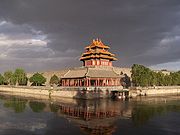
Quanzhou
Quanzhou is a prefecture-level city in Fujian province, People's Republic of China. It borders all other prefecture-level cities in Fujian but two and faces the Taiwan Strait...
in Fujian
Fujian
' , formerly romanised as Fukien or Huguing or Foukien, is a province on the southeast coast of mainland China. Fujian is bordered by Zhejiang to the north, Jiangxi to the west, and Guangdong to the south. Taiwan lies to the east, across the Taiwan Strait...
still contained one quarter vacant land by 1945. The city wall of Suzhou
Suzhou
Suzhou , previously transliterated as Su-chou, Suchow, and Soochow, is a major city located in the southeast of Jiangsu Province in Eastern China, located adjacent to Shanghai Municipality. The city is situated on the lower reaches of the Yangtze River and on the shores of Taihu Lake and is a part...
by the Republic of China
Republic of China
The Republic of China , commonly known as Taiwan , is a unitary sovereign state located in East Asia. Originally based in mainland China, the Republic of China currently governs the island of Taiwan , which forms over 99% of its current territory, as well as Penghu, Kinmen, Matsu and other minor...
era still contained large tracts of farmland. The City Wall of Nanjing
City Wall of Nanjing
The City Wall of Nanjing was designed by Emperor Zhu Yuanzhang after he founded the Ming Dynasty and established Nanjing as the capital 600 years ago. To consolidate his sovereignty and keep out invaders, he adopted the suggestions of advisor Zhu Sheng to build a higher city wall, to collect...
, built in the Ming Dynasty
Ming Dynasty
The Ming Dynasty, also Empire of the Great Ming, was the ruling dynasty of China from 1368 to 1644, following the collapse of the Mongol-led Yuan Dynasty. The Ming, "one of the greatest eras of orderly government and social stability in human history", was the last dynasty in China ruled by ethnic...
, enclosed an area large enough to house an airport, bamboo forests, and lakes in modern times.
Several features are typical of most Chinese city walls.
Shape
Where allowed by geography, Chinese city walls are rectangular in shape, with four orthogonal walls. Some wall systems are composed of a number of such rectangles, set adjacent to or concentrically within each other. For example, the city wall of BeijingBeijing
Beijing , also known as Peking , is the capital of the People's Republic of China and one of the most populous cities in the world, with a population of 19,612,368 as of 2010. The city is the country's political, cultural, and educational center, and home to the headquarters for most of China's...
is composed of four rectangles: a wider outer city to the south, a narrower inner city to the north, an imperial city
Imperial City (Beijing)
The Imperial City is a section of the city of Beijing in the Ming and Qing dynasties, with the Forbidden City at its center. It refers to the collection of gardens, shrines, and other service areas between the Forbidden City and the Inner City of ancient Beijing...
within the inner city, and the Forbidden City
Forbidden City
The Forbidden City was the Chinese imperial palace from the Ming Dynasty to the end of the Qing Dynasty. It is located in the middle of Beijing, China, and now houses the Palace Museum...
at the centre of that.
The walls could be constructed of a variety of materials. Common materials included rammed earth
Rammed earth
Rammed earth, also known as taipa , tapial , and pisé , is a technique for building walls using the raw materials of earth, chalk, lime and gravel. It is an ancient building method that has seen a revival in recent years as people seek more sustainable building materials and natural building methods...
, compressed earth block
Compressed earth block
Compressed Earth Block often referred to simply as CEB, is a type of manufactured construction material formed in a mechanical press that forms an appropriate mix of dirt, non-expansive clay, and an aggregate into a compressed block...
s, brick, stone, and any combination of these. In its standardised form during the Ming
Ming Dynasty
The Ming Dynasty, also Empire of the Great Ming, was the ruling dynasty of China from 1368 to 1644, following the collapse of the Mongol-led Yuan Dynasty. The Ming, "one of the greatest eras of orderly government and social stability in human history", was the last dynasty in China ruled by ethnic...
and Qing
Qing Dynasty
The Qing Dynasty was the last dynasty of China, ruling from 1644 to 1912 with a brief, abortive restoration in 1917. It was preceded by the Ming Dynasty and followed by the Republic of China....
dynasties, the wall was composed of a core made of compressed earth and mixed debris, strengthened by various binder
Cement
In the most general sense of the word, a cement is a binder, a substance that sets and hardens independently, and can bind other materials together. The word "cement" traces to the Romans, who used the term opus caementicium to describe masonry resembling modern concrete that was made from crushed...
s. The wall was then surfaced with bricks. It was topped with crenellations facing out, and a parapet
Parapet
A parapet is a wall-like barrier at the edge of a roof, terrace, balcony or other structure. Where extending above a roof, it may simply be the portion of an exterior wall that continues above the line of the roof surface, or may be a continuation of a vertical feature beneath the roof such as a...
facing in.
Gates
Gates were placed symmetrically along the walls. The principal gate was traditionally located at the centre of the south wall. Gatehouses were generally built of wood and brick, which sat atop a raised and expanded section of the wall, surrounded by crenellated battlements. A tunnel ran under the gatehouse, with several metal grates and wooden doors. CamouflageCamouflage
Camouflage is a method of concealment that allows an otherwise visible animal, military vehicle, or other object to remain unnoticed, by blending with its environment. Examples include a leopard's spotted coat, the battledress of a modern soldier and a leaf-mimic butterfly...
d defensive positions are placed along the tunnel (in an effect similar to murder holes). Gatehouses were accessed by ramps, called horse ramps or bridle paths
, , which sat against the wall adjacent to the gate.
Barbican
An "archery tower" was often placed in front of the main gatehouse, forming a barbicanBarbican
A barbican, from medieval Latin barbecana, signifying the "outer fortification of a city or castle," with cognates in the Romance languages A barbican, from medieval Latin barbecana, signifying the "outer fortification of a city or castle," with cognates in the Romance languages A barbican, from...
. In its final form during the Ming
Ming Dynasty
The Ming Dynasty, also Empire of the Great Ming, was the ruling dynasty of China from 1368 to 1644, following the collapse of the Mongol-led Yuan Dynasty. The Ming, "one of the greatest eras of orderly government and social stability in human history", was the last dynasty in China ruled by ethnic...
and Qing
Qing Dynasty
The Qing Dynasty was the last dynasty of China, ruling from 1644 to 1912 with a brief, abortive restoration in 1917. It was preceded by the Ming Dynasty and followed by the Republic of China....
dynasties, the archery tower was an elaborate construction, of comparable height to the main gatehouse, which stands some distance in front of the main gatehouse. At its base was a gate. The archery tower is so-named because of its rows of archery (and later cannon) placements, from which defenders could fire projectiles on attackers. Auxiliary walls, running perpendicularly to the main wall, connect the archery tower with the main gatehouse, enclosing a rectangular area. This area serves as a buffer zone, should the first gate be breached. Its Chinese
Chinese language
The Chinese language is a language or language family consisting of varieties which are mutually intelligible to varying degrees. Originally the indigenous languages spoken by the Han Chinese in China, it forms one of the branches of Sino-Tibetan family of languages...
name, "jar walls", refers to the intended strategy whereby attackers coming through the archery tower would be trapped in the barbican, open to attack from all sides.
In large gates there may be multiple barbicans - the main gate of Nanjing (Gate of China, Nanjing
Gate of China, Nanjing
The Gate of China in Nanjing , was a ceremonial gateway in Nanjing, China. It was the southern gate of Nanjing city. It is a renowned ancient city gate in China and the city gate with the most complex structure in the world.-History:...
) had three barbicans, forming the most elaborate system still in existence in China.
Towers
Towers that protruded from the wall were located at regular intervals along the wall. Large and elaborate towers, called corner towers (角楼), were placed where two walls joined (i.e. at corners). These were significantly higher than the wall itself, and gave defenders a bird's eye view over both the city and its surroundings.Moat
In larger cities, a moatMoat
A moat is a deep, broad ditch, either dry or filled with water, that surrounds a castle, other building or town, historically to provide it with a preliminary line of defence. In some places moats evolved into more extensive water defences, including natural or artificial lakes, dams and sluices...
surrounded the wall. This could be connected to canals or rivers both in the city and outside, thus providing both a defense and a convenient transportation route. Nearby waterways might be adopted or altered to connect to, or form part of, the moat.
Extant city walls
Being the last imperial capital of China, the city walls of Beijing survived in substantially complete form into the 1950s, but have suffered wholesale demolition in the decades since. Remnants of the wall system which can still be seen today include the wall of the Forbidden CityForbidden City
The Forbidden City was the Chinese imperial palace from the Ming Dynasty to the end of the Qing Dynasty. It is located in the middle of Beijing, China, and now houses the Palace Museum...
, which survives intact, various gates including Qianmen
Qianmen
Qianmen is the colloquial name for Zhengyangmen , a gate in Beijing's historic city wall. The gate is situated to the south of Tiananmen Square and once guarded the southern entry into the Inner City. Although much of Beijing's city walls were demolished, Qianmen remains an important...
, Tiananmen
Tiananmen
The Tiananmen, Tian'anmen or Gate of Heavenly Peace is a famous monument in Beijing, the capital of the People's Republic of China. It is widely used as a national symbol. First built during the Ming Dynasty in 1420, Tian'anmen is often referred to as the front entrance to the Forbidden City...
, Deshengmen
Deshengmen
Deshengmen is the name of a city gate that was once part of Beijing's northern city wall. It is one of Beijing's few preserved city gates and now stands as a landmark on the northern 2nd Ring Road....
, either surviving originals or restored, and other small surviving sections of wall.
Of the walls of other major historical cities, those of Nanjing
City Wall of Nanjing
The City Wall of Nanjing was designed by Emperor Zhu Yuanzhang after he founded the Ming Dynasty and established Nanjing as the capital 600 years ago. To consolidate his sovereignty and keep out invaders, he adopted the suggestions of advisor Zhu Sheng to build a higher city wall, to collect...
, Xi'an and Kaifeng
Kaifeng
Kaifeng , known previously by several names , is a prefecture-level city in east-central Henan province, Central China. Nearly 5 million people live in the metropolitan area...
are notable for their state of preservation. The walls of Nanjing and Xi'an are Ming Dynasty originals with extensive Qing Dynasty and modern restorations, while the wall of Kaifeng visible today is largely the result of Qing Dynasty restoration.
The walls of some smaller cities and towns have survived more or less intact. These include the walls of Pingyao
Pingyao
Pingyao is a Chinese city and county in central Shanxi province, China. It lies about 715 km from Beijing and 80 km from the provincial capital, Taiyuan. During the Qing Dynasty, Pingyao was a financial center of China...
in Shanxi
Shanxi
' is a province in Northern China. Its one-character abbreviation is "晋" , after the state of Jin that existed here during the Spring and Autumn Period....
, Dali in Yunnan
Yunnan
Yunnan is a province of the People's Republic of China, located in the far southwest of the country spanning approximately and with a population of 45.7 million . The capital of the province is Kunming. The province borders Burma, Laos, and Vietnam.Yunnan is situated in a mountainous area, with...
, Jingzhou
Jingzhou
Jingzhou is a prefecture-level city in Hubei Province, People's Republic of China. The city is located on the banks of the Yangtze River.Its population is 5,691,707 at the 2010 census whom 1,154,086 in the built up area made of 3 urban districts.-Geography:Jingzhou occupies an area of...
in Hubei
Hubei
' Hupeh) is a province in Central China. The name of the province means "north of the lake", referring to its position north of Lake Dongting...
, and Xingcheng
Xingcheng
Xingcheng , former name Ningyuan , is a county-level city of Northeast China with a population of approximately 140,000 urban inhabitants, and is located in southwest Liaoning on the northern coast of the Bohai Sea...
in Liaoning
Liaoning
' is a province of the People's Republic of China, located in the northeast of the country. Its one-character abbreviation is "辽" , a name taken from the Liao River that flows through the province. "Níng" means "peace"...
. Smaller garrison towns or fortifications include Fishing Town
Fishing town
Fishing Town or Fishing City , is one of the three great ancient battlefields of China. It is famous for its resistance to the Mongol armies in the latter half of the Song Dynasty...
near Chongqing, Wanping county fortifications near Marco Polo Bridge in Beijing, the garrison town of Shanhai Pass
Shanhai Pass
Shanhai Pass , or Shanhaiguan, along with Jiayu Pass and Juyong Pass, is one of the major passes of the Great Wall of China It is located in Shanhaiguan District, Qinhuangdao, Hebei. In 1961, Shanhaiguan became a site of China First Class National Cultural Site.It is a popular tourist destination,...
, and Qiansuo in Huludao
Huludao
Huludao is a prefecture-level city in southwestern Liaoning Province, China. It is one of the two principal cities in the Liaoxi Corridor . Known as Jinxi until 1994, Huludao has a total area of 10,415 square kilometers and a population of 2.87 million, of which some 531,000 live in the city proper...
, Liaoning
Liaoning
' is a province of the People's Republic of China, located in the northeast of the country. Its one-character abbreviation is "辽" , a name taken from the Liao River that flows through the province. "Níng" means "peace"...
.
Isolated remnants and some modern recreations can be seen today in many other cities. The walls of Luoyang
Luoyang
Luoyang is a prefecture-level city in western Henan province of Central China. It borders the provincial capital of Zhengzhou to the east, Pingdingshan to the southeast, Nanyang to the south, Sanmenxia to the west, Jiyuan to the north, and Jiaozuo to the northeast.Situated on the central plain of...
in Henan survive as heavily eroded remains. The surviving walls of Shangqiu
Shangqiu
Shangqiu is a city in eastern Henan province, Central China. It borders Kaifeng to the northwest, Zhoukou to the southwest, and the provinces of Shandong and Anhui to the northeast and southeast respectively. An ancient city with a rich history, Shangqiu was also the first capital of the Shang...
in Henan
Henan
Henan , is a province of the People's Republic of China, located in the central part of the country. Its one-character abbreviation is "豫" , named after Yuzhou , a Han Dynasty state that included parts of Henan...
, while extensive, have heavily deteriorated over time. Only small parts of the city walls protecting the Confucian compound in Qufu
Qufu
Qufu is a city in southwestern Shandong province, People's Republic of China. It is located at 35° 36′ northern latitude and 117° 02′ east, about south of the provincial capital Jinan and northeast of the prefecture seat at Jining...
are authentic, the rest having been demolished in 1978 and rebuilt in recent years. Some isolated gates of Hangzhou
Hangzhou City Walls
The first defensive barrier in the Hangzhou area can be traced back 5000 years to the Neolithic jade-carving Liangzhu Culture. The Liangzhu culture built earthen walls that served two purposes, to protect their settlements from invaders and to serve as dikes to prevent flooding...
and Suzhou
Suzhou
Suzhou , previously transliterated as Su-chou, Suchow, and Soochow, is a major city located in the southeast of Jiangsu Province in Eastern China, located adjacent to Shanghai Municipality. The city is situated on the lower reaches of the Yangtze River and on the shores of Taihu Lake and is a part...
(especially Panmen Gate) have either survived or been rebuilt. Substantial remains of the gates of Zhengding
Zhengding
Zhengding is a county in Hebei Province approximately 260 kilometers south of Beijing, China. It comes under the administration of nearby Shijiazhuang City and has a population of 594,000. Zhengding has been an important religious center for more than 1,000 years, from - at least - the times...
in Hebei
Hebei
' is a province of the People's Republic of China in the North China region. Its one-character abbreviation is "" , named after Ji Province, a Han Dynasty province that included what is now southern Hebei...
have survived but the walls have largely been stripped to their earthen core. One small section of the city wall of Shanghai
Shanghai
Shanghai is the largest city by population in China and the largest city proper in the world. It is one of the four province-level municipalities in the People's Republic of China, with a total population of over 23 million as of 2010...
is visible today.

